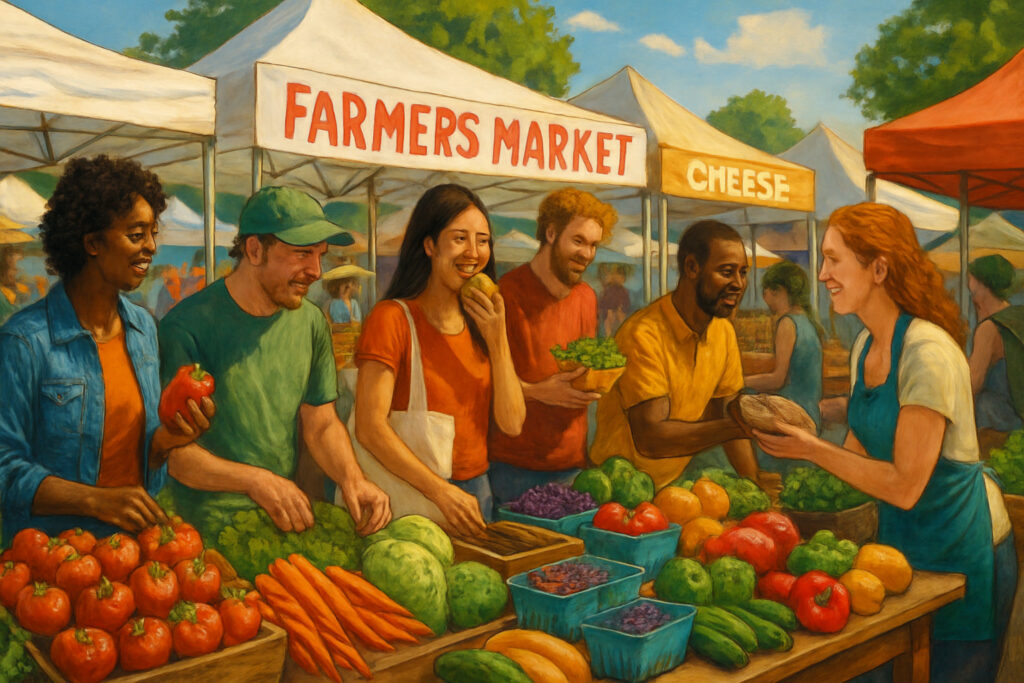Why Sustainable Food Tourism is Changing How We Travel
Sustainable food tourism combines your love of great food with caring for the planet and local communities. It’s about choosing restaurants that source ingredients locally, support small farmers, and preserve traditional cooking methods instead of eating at global chains.
What sustainable food tourism includes:
- Farm-to-table dining – Restaurants that source directly from local farms
- Seasonal menus – Eating foods that grow naturally in the area during your visit
- Traditional cooking methods – Experiencing authentic recipes passed down through generations
- Zero-waste practices – Restaurants that compost scraps and use reusable containers
- Community support – Dining choices that keep money in local economies
Every pound spent at independent restaurants stays in the local economy 3.5 times longer than money spent at large chains. That’s real impact from your dining choices.
Farm-to-table restaurants can reduce carbon emissions by up to 57% compared to large chains. Industrial food chains like McDonald’s produce 2.5kg of CO₂ per meal – three times the 0.8kg generated by farm-to-table restaurants.
But sustainable food tourism isn’t just about the environment. It’s about authentic experiences that connect you with local culture. 67% of travelers now put food experiences at the heart of their trip planning.
When you choose sustainable food tourism, you’re supporting women-led kitchens in Morocco, helping preserve ancient cooking techniques, and ensuring traditional recipes survive for future generations.
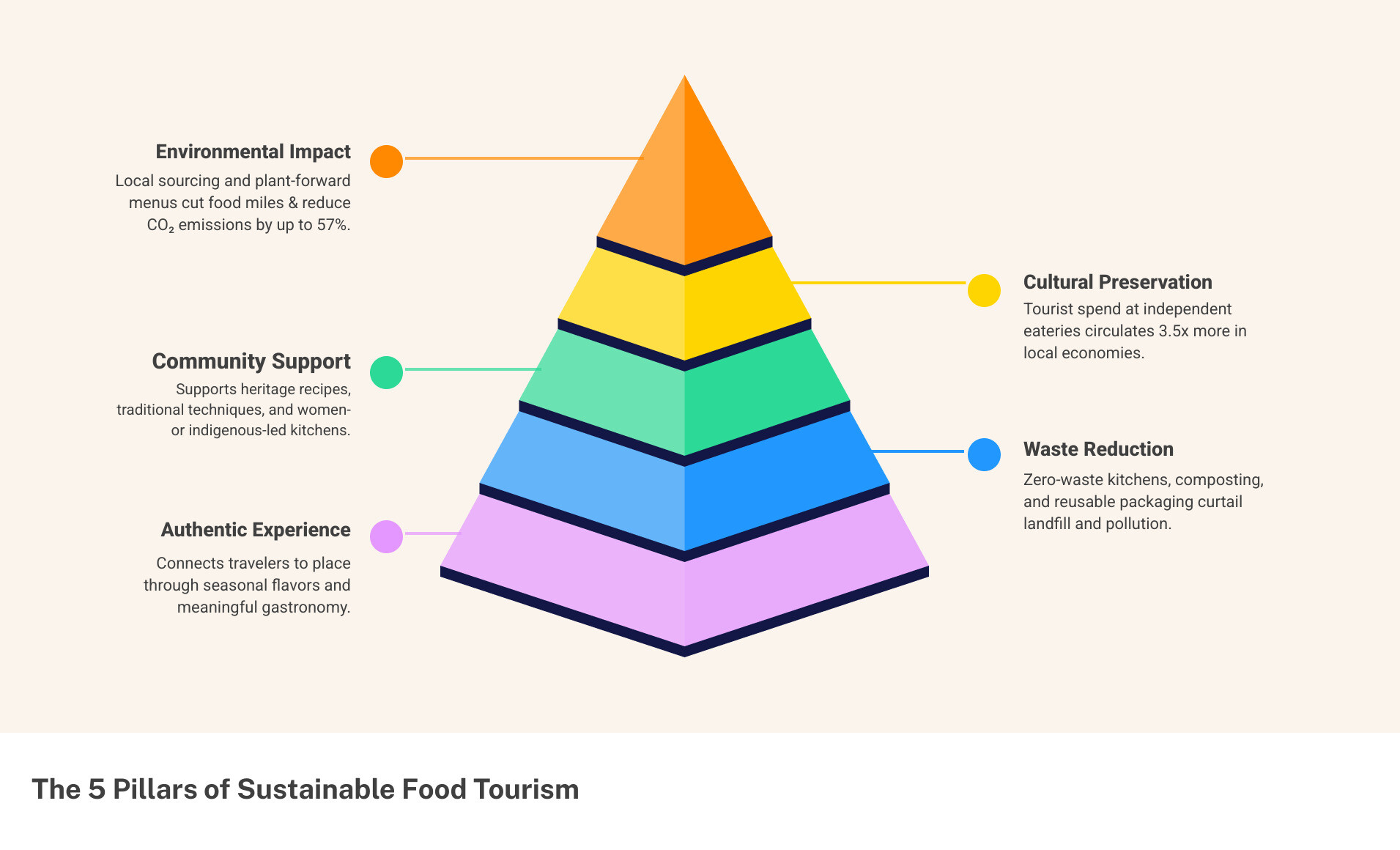
Sustainable food tourism vocab to learn:
What Is Sustainable Food Tourism?
Sustainable food tourism is about finding the true flavors of a place while caring for the environment and local communities. It’s the art of eating your way through destinations in a way that’s good for you, good for the planet, and good for the people who call that place home.
Think of it as the opposite of grabbing a quick burger at the airport. Instead, you’re seeking out that family-run taverna in Greece where the tomatoes come from the garden out back, or the Bangkok street vendor who’s been perfecting her pad thai recipe for three generations.
This approach follows the three pillars of the Sustainable Food Movement: good (delicious and nutritious), clean (produced without harming the environment), and fair (socially responsible and economically viable for producers).
Zero-mile sourcing takes this concept to its logical conclusion – restaurants that grow their own herbs on rooftops or source vegetables from farms you could walk to. Seasonal menu rotations mean your spring meal in Tuscany will taste completely different from your autumn visit, because chefs work with what nature provides.
The magic happens when you encounter hyperlocal ingredients – those special products that exist nowhere else. Maybe it’s the specific variety of cheese that comes from goats grazing on Mediterranean hillsides, or the wild mushrooms that only grow in Pacific Northwest forests.
This creates “sense-of-place dining” – meals that tell the story of where you are through every bite. The Slow Food movement, born in Italy as a response to fast food culture, has championed this philosophy for decades.
How It Differs From Conventional Food Tourism
The difference between sustainable and conventional food tourism is like comparing a handwritten letter to a mass-produced postcard. Both might get the message across, but only one has soul.
Conventional food tourism often means playing it safe with familiar global chains and standardized menus. You know exactly what you’re getting, but you’re missing the chance to truly taste where you are.
Sustainable food tourism accepts the beautiful unpredictability of local food systems. It means accepting that the restaurant might be out of your first choice because the fishing boats didn’t go out yesterday, or finding that the strawberries taste incredible because they’re perfectly in season.
The environmental impact tells a compelling story. Global chains produce three times more CO₂ per meal than farm-to-table venues. Chain supply systems reduce crop diversity by 78%, while regional supply chains cut the need for refrigeration and long-distance transport by around 17%.
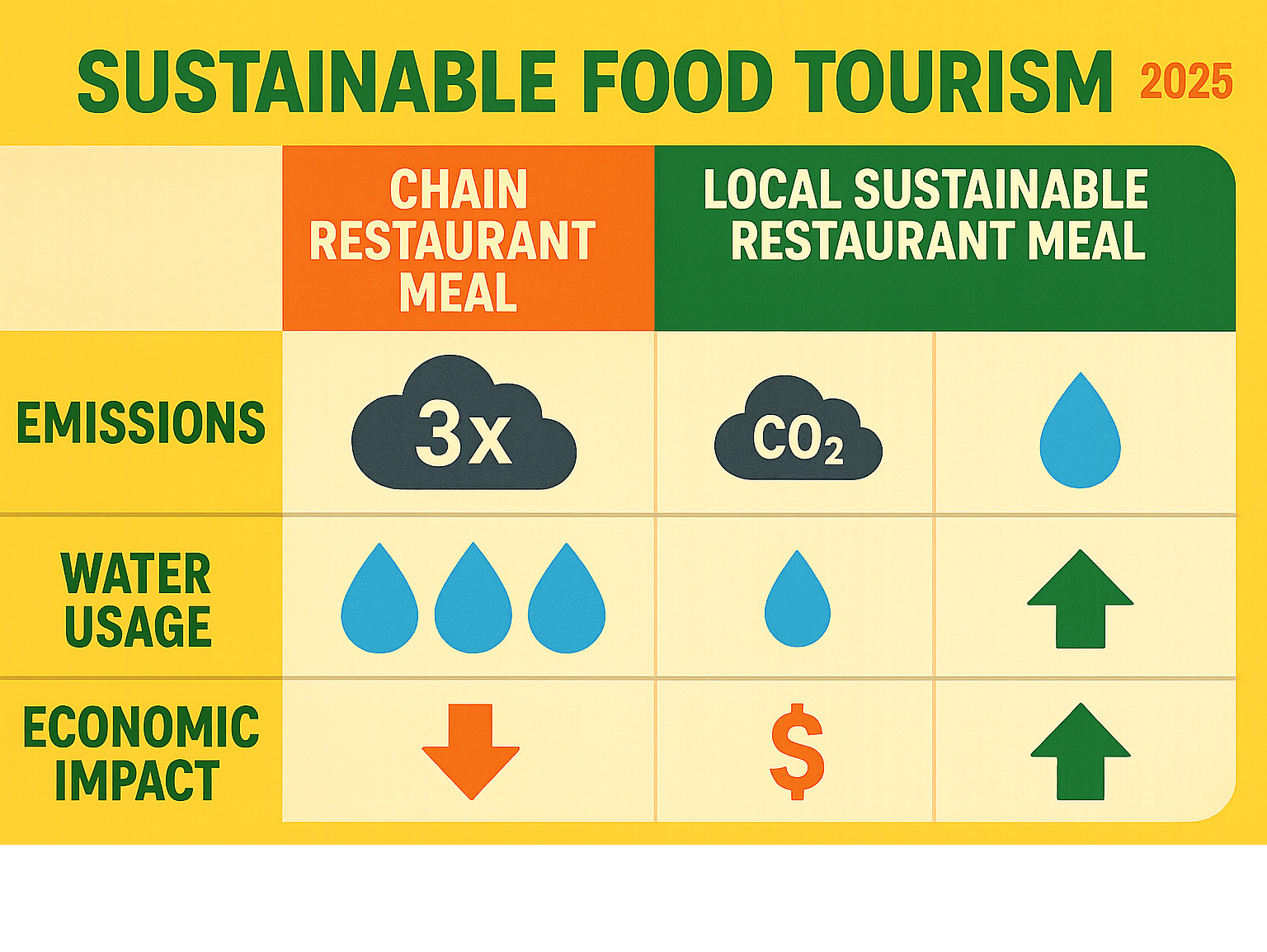
When you choose that local bistro over the familiar chain, you’re voting with your wallet for a food system that celebrates diversity, supports small farmers, and keeps culinary traditions alive.
The Triple-Win Benefits of Sustainable Food Tourism
When you choose sustainable food tourism, you’re creating positive change that ripples through communities and ecosystems. This approach delivers a “triple-win”: measurable benefits for our planet, local people, and economic prosperity.
Every meal you eat while traveling is a vote for the kind of world you want to live in. The research backs this up with compelling numbers that show sustainable choices create lasting impact.
Planet: Lower Emissions & Waste
The environmental wins from sustainable food tourism are remarkable. When restaurants source ingredients locally, they slash refrigeration and transport needs by 17% compared to industrial farming systems.
Restaurants embracing circular economy principles are cutting waste by 60% through smarter resource management. They’re turning food scraps into biogas, composting organic waste, and creating closed-loop systems that eliminate the concept of “waste” entirely.
The water savings are staggering. Industrial beef production guzzles 1,800 litres of water per kilogram, while local vegetables need just 250 litres. Scientific research on meat production reveals that meat accounts for 57% of greenhouse gases in food production.
Your choices make a real difference: plant-based and sustainable seafood meals generate 58% fewer greenhouse gases than meat-based dishes. Using reusable containers during food tours cuts plastic usage by 92%. Sharing meals with fellow travelers reduces waste by 37%.
People: Cultural Heritage & Social Equity
Sustainable food tourism preserves something precious that can’t be replaced: the stories, traditions, and knowledge passed down through generations. UNESCO recognizes 38 food traditions as Intangible Cultural Heritage, highlighting how deeply food connects us to our human identity.
Women often serve as the guardians of traditional food knowledge, and sustainable tourism gives them economic power. In Morocco, women-led farm-to-table restaurants offer visitors authentic cultural experiences while creating meaningful employment.
Gastrodiplomacy shows how food builds bridges between cultures. Thailand’s Global Thai campaign promoted their culture worldwide through food, while traditional communal meals in Indonesia draw tourists and preserve customs simultaneously.
Community restaurants like Parwa in Peru reinvest 100% of profits into youth education programs. The Huchuy Qosco group increased youth employment by 40% through culinary tours, creating opportunities for young people to stay in their communities while sharing their heritage.
Profit: Local Economic Multiplier
Sustainable food tourism really shines economically. Culinary travelers spend 34% more per trip than regular tourists, and their money creates a multiplier effect that benefits entire communities.
Every pound spent at independent restaurants circulates £3.50 in the local economy – that’s real economic impact. For every 10 jobs created in food tourism, seven additional positions emerge in transport, retail, and other supporting industries.
More than 60% of tourists say food experiences are central to what makes a destination special. Food and gastronomy account for 40% of the world’s tourism expenditure. In Spain, food-motivated tourists spend 20% more than average visitors.
Why Locally Sourced Ingredients Make a Difference becomes crystal clear when you see how this spending pattern creates jobs, preserves traditions, and builds community resilience.
How Travellers Can Practise Sustainable Food Tourism
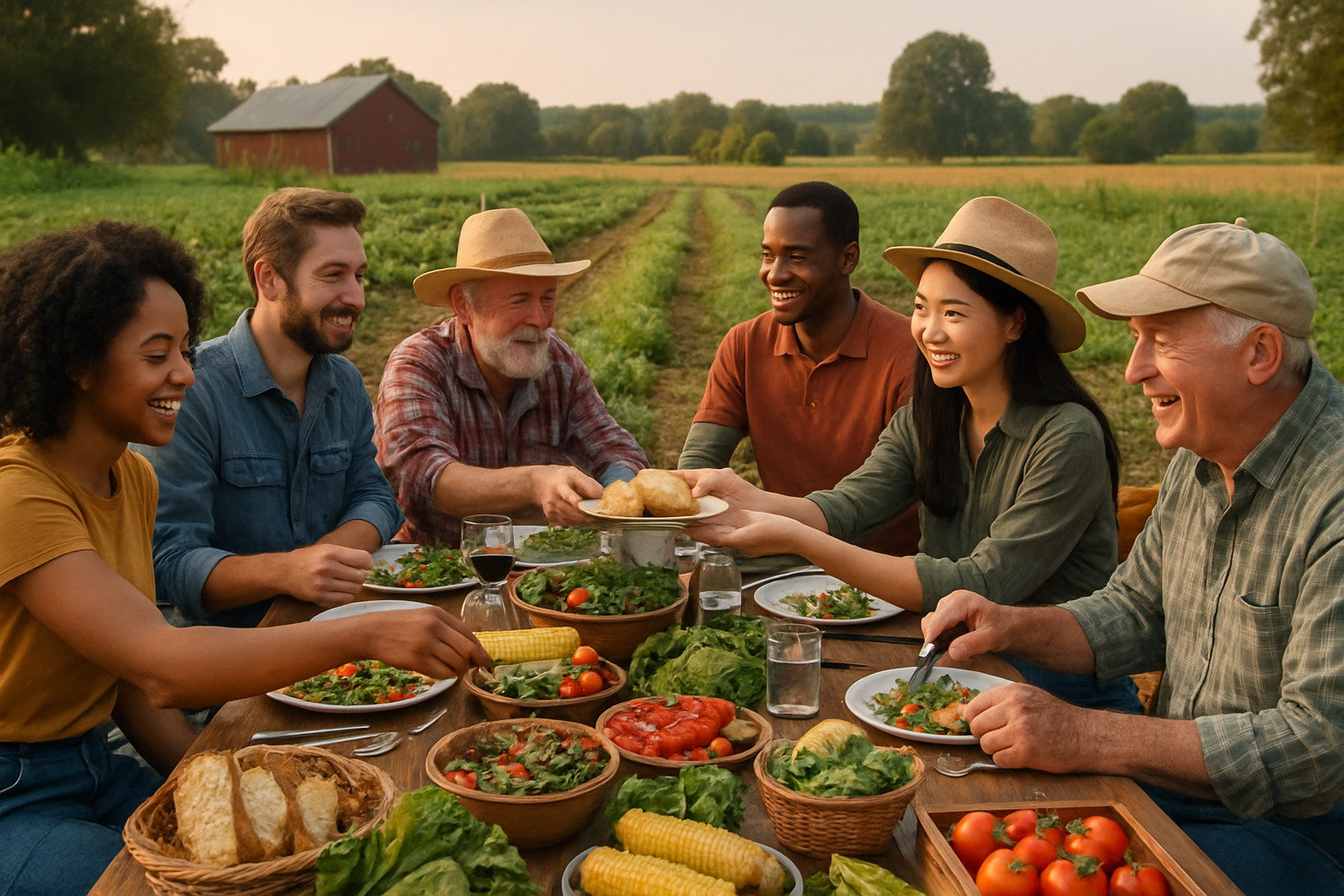
Ready to transform your travel through food? Sustainable food tourism isn’t about limiting your choices – it’s about making better ones that create incredible experiences while helping the planet and local communities.
The beauty of sustainable eating while traveling is that it often leads to your most memorable meals. When you choose local over global, seasonal over shipped, and authentic over artificial, you’re opening up flavors and experiences you simply can’t get anywhere else.
Support Local Farms and Markets
There’s something magical about wandering through a farmers market in a new place. The colors, smells, and sounds tell the story of where you are better than any guidebook ever could.
Farmers markets offer the perfect entry point into sustainable eating. Start your day early when the selection is best and vendors have time to chat. Ask about their growing methods, seasonal specialties, and crops you’ve never seen before.
Bring a cooler or insulated bag to keep fresh purchases chilled, and don’t be afraid to buy ingredients for picnics or to take back to accommodations with kitchens. Some of the best travel memories come from impromptu meals made with ingredients you found that morning.
Seasonal eating becomes an trip when you accept what’s naturally available. Spring asparagus in Europe tastes nothing like the imported version back home. Summer stone fruits in Mediterranean climates burst with flavors that simply can’t survive long-distance shipping.
Zero-mile sourcing takes this concept to its logical conclusion. Some restaurants grow their own ingredients or source from farms within walking distance. These Farm-to-Table Dining Experiences offer the ultimate in freshness and sustainability.
Choose Planet-Friendly Plates (Plant-Based & Seafood)
You don’t need to become vegetarian overnight to make a difference, but shifting toward plant-based options while traveling opens up incredible culinary possibilities. Plant proteins require 75% less water than beef, and every culture has developed amazing ways to make vegetables shine.
Wild-caught seafood deserves special recognition as one of the most sustainable proteins available. It requires no land or freshwater inputs, and coastal communities have perfected preparation methods over generations. Look for certifications like Marine Stewardship Council (MSC) or simply ask your server about sourcing practices.
Traditional fermented foods offer another fantastic option. From Korean kimchi to German sauerkraut, these dishes pack incredible flavor while supporting beneficial bacteria and reducing waste.
The key is choosing dishes that celebrate local ingredients and traditional preparation methods. Sustainable Menu Options vary dramatically by region, but the principle remains constant: when food reflects its place of origin, it’s usually more sustainable and more delicious.
Minimise Waste on the Go
Food waste might seem like a small issue when you’re on vacation, but smart travelers know that small actions multiply into big impacts. Sharing meals within your travel group can reduce waste by 37% while letting you try more dishes.
Portion sharing works especially well with family-style cuisines like tapas, mezze, or dim sum. You get variety, the restaurant wastes less, and you often spend less money too.
Many restaurants now offer compostable packaging for takeout, and some progressive destinations provide reusable containers for tourists. When possible, take leftovers with you – that amazing pasta might make an even better lunch tomorrow.
Bringing your own reusable containers and water bottles eliminates single-use plastics while giving you flexibility. Sustainable Dining Practices include asking about portion sizes and choosing restaurants with waste management programs.
Leverage Tech for Good
Technology is revolutionizing sustainable food tourism in ways that seemed impossible just a few years ago. Apps like Eatwith connect travelers with local home cooks, creating authentic experiences while supporting community members directly.
Augmented reality menus help restaurants highlight their most sustainable dishes, increasing selection of eco-friendly options by 41%. When you can see exactly how a dish is prepared and where ingredients come from, making conscious choices becomes effortless.
Blockchain QR codes might sound complicated, but they’re simple to use – just scan and trace your ingredients from farm to plate. This transparency helps you make informed decisions while supporting restaurants committed to responsible sourcing.
Geolocated search tools drive 62% more foot traffic to family-run eateries, helping you find hidden gems that might not have big marketing budgets. These apps often surface the exact kind of authentic, local experiences that make travel memorable.
Success Stories & Emerging Innovations in Sustainable Food Tourism
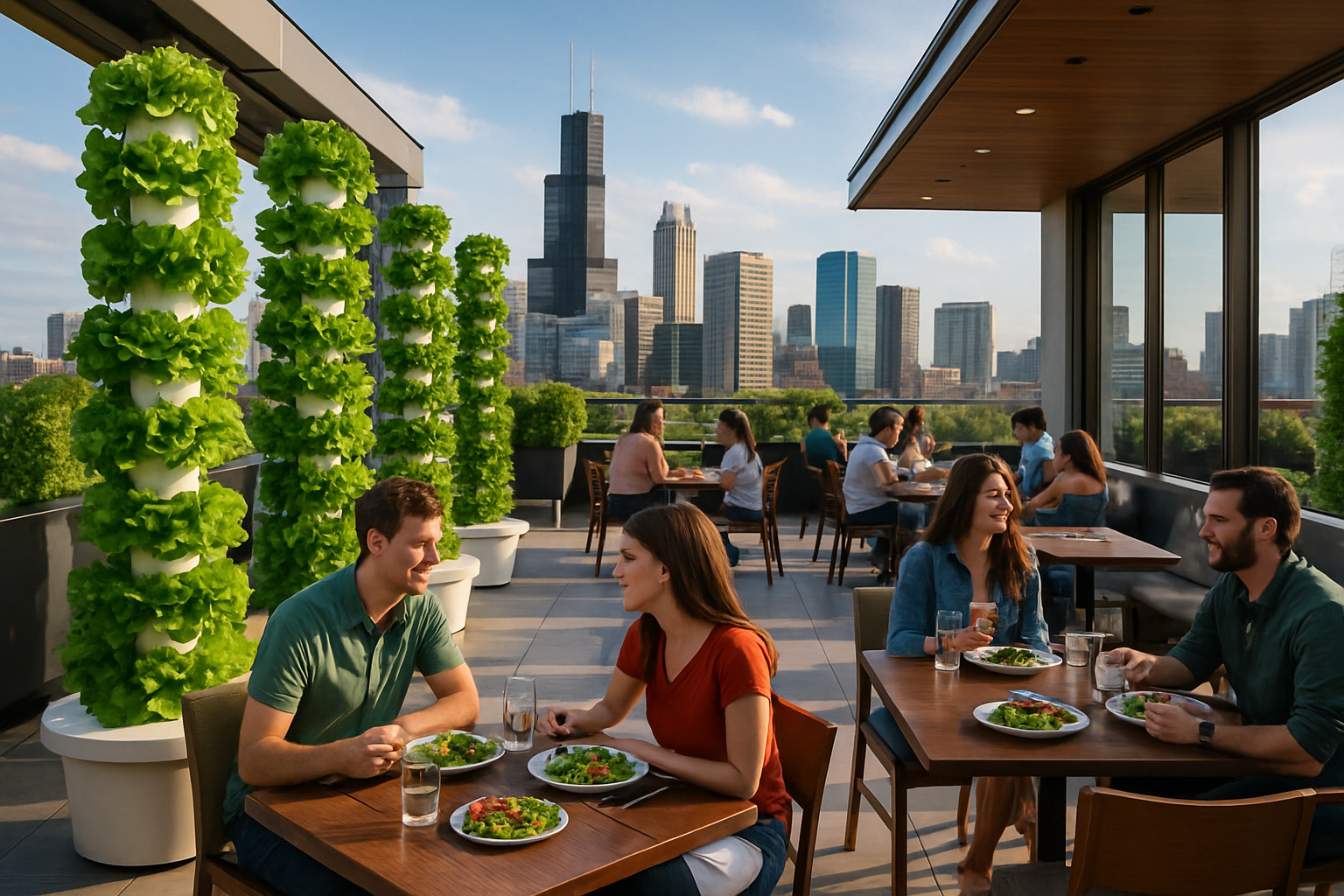
The sustainable food tourism movement isn’t just a trend – it’s creating real change around the world. From rooftop gardens in busy cities to zero-waste kitchens in remote villages, innovative approaches are proving that good food and environmental responsibility go hand in hand.
Global Case Studies that Inspire
Parwa Community Restaurant in Peru shows what happens when tourism truly serves the community. This remarkable restaurant doesn’t just serve authentic Peruvian cuisine – it reinvests 100% of its profits into youth education programs. Every meal you eat there directly funds local children’s futures.
The Huchuy Qosco group in the same region has created something special too. Their culinary tours increased youth employment by 40%, giving young people reasons to stay in their communities instead of moving to cities.
Bo.lan Restaurant in Bangkok proves that urban dining can be incredibly sustainable. This award-winning restaurant grows ingredients on its own organic farm and sources from nearby producers. Their zero-waste kitchen shows that sustainability and culinary excellence aren’t just compatible – they improve each other.
Cornwall’s remarkable recovery after the 2001 foot and mouth epidemic demonstrates how food tourism can revitalize entire regions. The crisis caused £2 billion in tourism losses, but Cornwall rebuilt around local sourcing and regional specialties. Today, food tourism supports 25% of local jobs there.
The Upper Tanaro Valley in Italy exemplifies the Slow Food movement’s impact. Artisanal bakeries that were once struggling have become tourist destinations through Slow Food presidia.
Meanwhile, the contrast with global chains is striking. With over 40,000 McDonald’s outlets worldwide, standardized food dominates the landscape. But these success stories prove that sustainable alternatives can thrive and create more meaningful experiences.
Future Trends to Watch
The future of sustainable food tourism is being shaped by incredible innovations that would have seemed like science fiction just a few years ago.
Vertical farming is revolutionizing how restaurants source ingredients. Imagine dining in a restaurant where your salad grows on the wall beside your table. These systems eliminate food miles entirely while providing the freshest possible ingredients.
3D food printing might sound gimmicky, but it’s becoming a powerful tool for preserving culinary heritage. Chefs can now recreate lost traditional recipes with historical precision, bringing ancient dishes back to life for modern diners.
Carbon labeling is becoming standard practice. Soon, you’ll see the environmental impact of every dish listed right on the menu, just like calories. This transparency helps diners make informed choices without any guesswork.
Regenerative agriculture is moving beyond sustainability to actually healing the land. Farms that practice these methods are becoming tourist destinations themselves, showing visitors how food production can improve the environment.
The Michelin Green Star program now recognizes restaurants with outstanding commitment to sustainability. This prestigious recognition is driving more chefs to adopt eco-friendly practices while maintaining world-class standards.
Blockchain traceability lets you scan a QR code and see exactly where your ingredients came from – which farm, when they were harvested, and how they traveled to your plate.
Food Sustainability Trends point toward a future where technology improves rather than replaces traditional food culture.
Challenges & Solutions for Operators and Policymakers
Sustainable food tourism sounds wonderful in theory, but the reality is messier. Restaurant owners face real problems when trying to go green, while policymakers struggle to create frameworks that actually work.
The biggest challenge? Money. Getting certified as sustainable can cost thousands – a huge burden for small family restaurants already operating on thin margins. Many operators want to source locally but lack the digital marketing skills to compete with global chains.
Then there’s the land issue. As tourism grows, property prices skyrocket, pushing small farms out of business. Climate change adds another layer of complexity. Traditional recipes depend on specific ingredients that may no longer grow reliably in their native regions.
But smart solutions are emerging. Shared certification programs let multiple restaurants split costs, making sustainability affordable for smaller operators. Digital marketing cooperatives help family-run places compete online without breaking the bank.
Land trusts are protecting agricultural areas from development, ensuring future generations can still experience authentic farm-to-table dining. Meanwhile, climate-resilient crop varieties help maintain local food security even as weather patterns change.
Collaborations That Work
The most exciting progress happens when different groups work together. The European Union’s Farm to Fork Strategy puts €10 billion toward supporting regional food systems – that’s real money creating real change.
Italy shows how government investment pays off. Their €200 million food tourism fund created 12,000 jobs while protecting culinary heritage. France’s Loi EGAlim policy requires half of school meals to meet sustainability criteria, boosting organic farm revenues by 27%.
The Slow Food movement proves that grassroots efforts can scale up. Their presidia programs connect small producers directly with tourism markets, cutting out middlemen and keeping more money in local communities.
Green Restaurant Certifications are becoming more accessible through collaborative programs. When restaurants band together, they can share both costs and expertise.
Successful sustainable food tourism requires partnerships between restaurants, farms, governments, and certification bodies. When everyone works together, the challenges become manageable and the benefits multiply.
Frequently Asked Questions about Sustainable Food Tourism
How is “sustainable food tourism” different from “farm-to-table”?
Think of sustainable food tourism as the big picture, while farm-to-table is just one beautiful piece of the puzzle. Farm-to-table focuses specifically on restaurants sourcing ingredients from local farms – which is wonderful! But sustainable food tourism takes a much broader view of your entire culinary travel experience.
When you practice sustainable food tourism, you’re considering everything from the accommodations you choose to the waste you create, the communities you support, and the cultural traditions you help preserve. Farm-to-table dining is definitely part of this approach, but so is eating at street food stalls, shopping at farmers markets, taking cooking classes with local families, and even choosing restaurants that pay fair wages to their staff.
The key difference is scope. Farm-to-table is about where your food comes from, while sustainable food tourism is about the entire impact of your food choices while traveling. It’s the difference between asking “Is this locally grown?” and asking “How does my entire food journey support the places I visit?”
Can I practise sustainable food tourism on a budget?
Here’s the best news about sustainable food tourism – it often saves you money! When you eat where locals eat instead of at tourist-trap restaurants, you’re not just being more sustainable, you’re usually spending less too.
Street food and local markets are often your most authentic and affordable options. That family-run noodle shop locals love? It’s probably half the price of the hotel restaurant and twice as delicious. Farmers markets let you create amazing picnics with the freshest ingredients at a fraction of restaurant prices.
Seasonal specialties are another budget-friendly win. When you eat what’s naturally available during your visit, you’re getting the best prices because there’s no expensive shipping or storage involved. Those perfect summer tomatoes or autumn apples taste better and cost less.
Community kitchens and cooking classes using local ingredients often provide incredible value too. You get a meal, learn new skills, and support local families – all for less than you’d spend at a fancy restaurant.
Every pound you spend at independent restaurants circulates through the local economy 3.5 times longer than money spent at chains. Your budget goes further in creating positive impact.
What labels or apps help verify sustainable dining spots?
The world of sustainability certifications can feel overwhelming, but a few key labels make spotting genuinely sustainable restaurants much easier. Look for Green Standards, BREEAM, ENERGY STAR, or FSC marks – these show restaurants have met strict environmental criteria.
For seafood specifically, the Marine Stewardship Council (MSC) certification ensures your fish comes from sustainable fisheries. The Rainforest Alliance certification indicates responsible sourcing practices, while Slow Food Presidia recognition highlights restaurants preserving traditional food culture.
Technology is making sustainable dining findy much simpler too. The Eatwith app connects you directly with local chefs and home cooks, creating authentic experiences while supporting community members. Many geolocated search tools now include sustainability filters that help you find family-run eateries over chain restaurants.
Some newer restaurant apps even include carbon footprint tracking, letting you see the environmental impact of different menu choices. This transparency helps you make informed decisions that align with your values.
The trend is clear – over 80% of travelers now actively seek carbon labels and sustainability information when choosing where to eat. Restaurants are responding by making their practices more transparent and their certifications more visible.
Conclusion
Sustainable food tourism represents more than just a passing trend – it’s fundamentally reshaping how we connect with places through their food. When you choose that family-run trattoria over the familiar chain restaurant, or when you savor seasonal vegetables at a farmers market instead of imported produce, you’re participating in something bigger than a meal.
The numbers tell an inspiring story. If travelers acceptd sustainable dining practices, we could reduce global food-related emissions by 12% by 2030. That’s the kind of impact that happens when millions of individual choices add up to collective change.
Think about it: every time you eat locally-sourced food, you’re supporting small farmers, preserving traditional recipes, and keeping money in communities that need it most. You’re also treating yourself to more authentic, flavorful experiences that you simply can’t get from standardized global menus.
At The Dining Destination, we’ve seen how sustainable food tourism creates the most memorable travel experiences. Whether you’re finding hidden gems in New York City’s diverse neighborhoods or planning culinary trips elsewhere, there’s something magical about food that tells the story of its place.
The choice is yours every time you sit down for a meal while traveling. You can choose convenience and familiarity, or you can choose to taste the place, support the people, and protect the planet. One path gives you a meal you could get anywhere. The other gives you memories, connections, and the satisfaction of knowing your travel dollars are making a positive difference.
Your next culinary trip awaits, and it starts with a simple decision: where will you eat, and what story will that meal tell? Ready to explore how your food choices can transform your travels? Find more insights in our guide to Sustainable Tourism and start planning trips that satisfy both your appetite and your conscience.

